Below will tell you where should you place an area rug in a bedroom. The dos and don’ts of placing an area rug in a bedroom.
The most typical location for an area rug in a bedroom is underneath the bed, where it serves to anchor the biggest piece of furniture in the space. If there are nightstands on either side of the bed, decide whether you want the rug to end before the front legs of the nightstands or continue underneath them all the way to the headboard.
Continue reading.
Where Should You Place An Area Rug in a Bedroom?
Here are the details:
Under the Bed
The most typical location for an area rug in a bedroom is underneath the bed, where it serves to anchor the biggest piece of furniture in the space. If you have nightstands flanking the bed, decide whether you want the rug to go underneath them—all the way to the headboard—or stop before the nightstands’ front legs.
“Running the rug to the end of your headboard allows for the rug to be underfoot when you get out of bed, instantly creating a sense of coziness,” says James Seuss, CEO of The Rug Company. On the other hand, leaving some space before your bedside tables adds a soft layer to any room. “With this layout, it’s best to display the rug perpendicular to the bed frame so there is plenty of comfort on each side and foot of your bed,” Seuss says.
- Sizing a Rug for Under the Bed
Anything smaller will be too narrow for a king-size bed; your rug should be at least 9 x 12 feet in size. “For under a queen-sized bed, I’d look for at least 9- to 10-feet wide so you have plenty of rug to step out of the bed onto,” Curtis says.
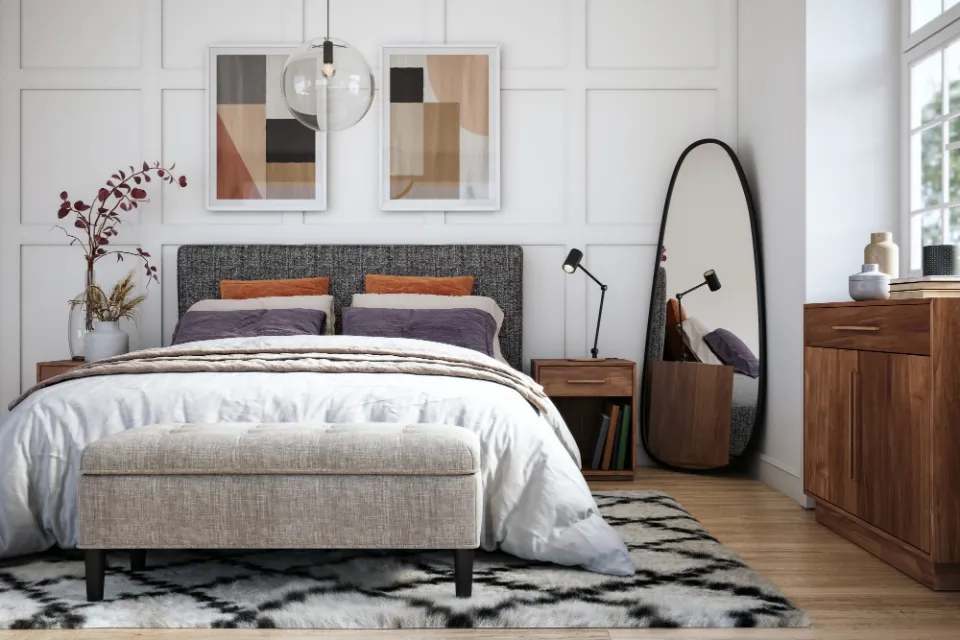
Next to the Bed
Instead of buying a rug that will be nearly completely obscured by your bed, opt for runners. “If you can’t [buy] the right sized rug for your room, then opt for two smaller sized rugs on either side of the bed,” says Curtis. “When you get out of bed, they will be comfortable and [their beauty] will be there for you to enjoy.”
- Sizing a Rug for Next to the Bed
Depending on how much room you have, choose longer runners to go the entire length of your bed or smaller accent rugs to provide a warm landing spot for chilly feet in the morning. “Often, it’s best to order a custom-length runner so that it fits the space precisely and has natural starting and finishing points,” says Seuss. “Larger rugs are always preferable!”
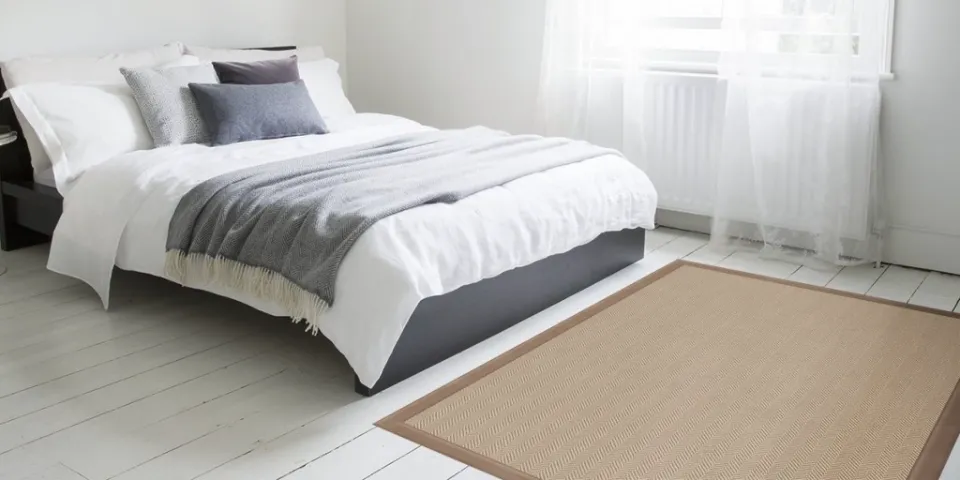
Under Furnishings
Rug size and placement can also be influenced by other pieces of furniture in the room, such as dressers and seating areas. A rug is typically required to complete any seating arrangement, including a desk or reading nook.
- Sizing a Rug for Under Furnishings
For the ideal rug size to place beneath furniture, there are fewer strict guidelines. “If the rug goes halfway under your dresser, that’s ideal—if it clears it all the way, it might be too small for the room,” says Curtis, rugs that are too small will not act as a focal point in your room; rather, they will appear lost in it. Choose a larger size and let your rug extend past the boundaries of your furniture instead.
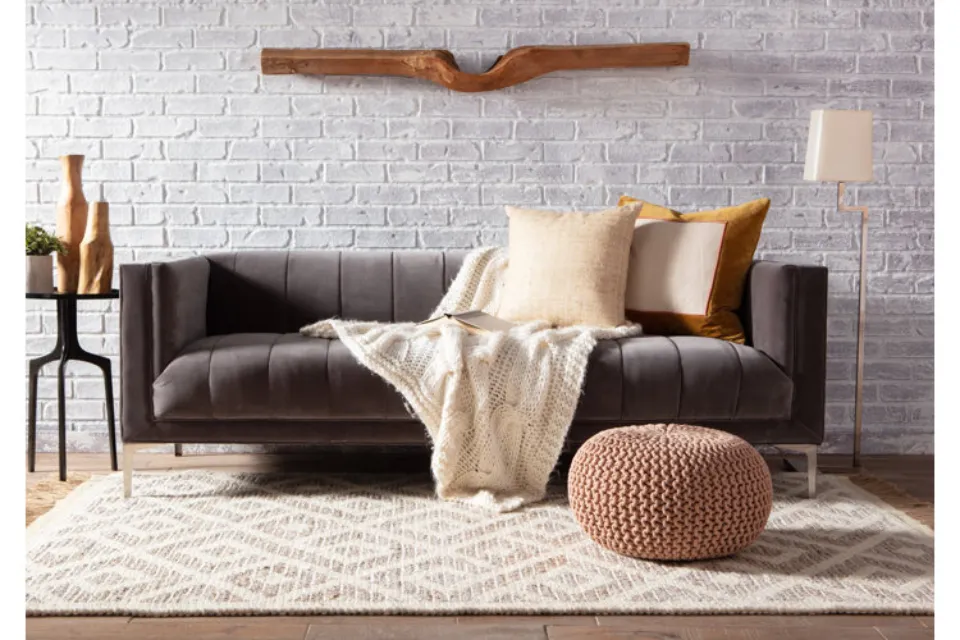
The Dos and Don’ts
Here are what you need to take care of:
Do Cover High-Traffic Spaces
The foot traffic in high-traffic areas of your bedroom is much higher than in other areas. Because of this, the floor there degrades more quickly over time. Every homeowner is aware of how expensive flooring is. An area rug will be especially useful if you have high-maintenance floors, like hardwood floors.
Make sure you learn how to find the perfect bedroom rug that’s made from sturdy, long-lasting materials. This will safeguard the flooring directly beneath the rug and spare you from having to replace it on a regular basis because it is matted or worn.
Do Leave Equal Space
A more symmetrical appearance is produced by leaving an equal distance between the end of the rug and each wall in the space.
Symmetrical patterns naturally attract people because they are more aesthetically pleasing. Therefore, adding this will give your bedroom a visually appealing and well-balanced appearance.
Rugs should typically not cover the entire floor, either. Wall-to-wall carpeting is an option if you want something that does.
Don’t Go Too Small in Size
A rug that is too small gives the impression of having been awkwardly added in after the fact rather than being part of the design. Instead of enhancing the space, it gets lost in the rest of the room.
Go big or go home, baby, if you have to decide between buying a rug that is too small or too big! With a larger rug, you’ll have the convenience of being able to place all of your furniture there without having them look crammed into a small area.
A rug that will be ideal for its purpose and appropriate in size for the other bedroom furniture should be purchased.
Don’t Be Afraid of Colour
Rugs can also be a fun and interesting way to decorate a space without being overpowering.
You could also stick to a theme and choose a rug of the same color or print as your bedding or some of the accessories and throw blankets in your bedroom. This is a unique way to make the space cohesive as a whole.
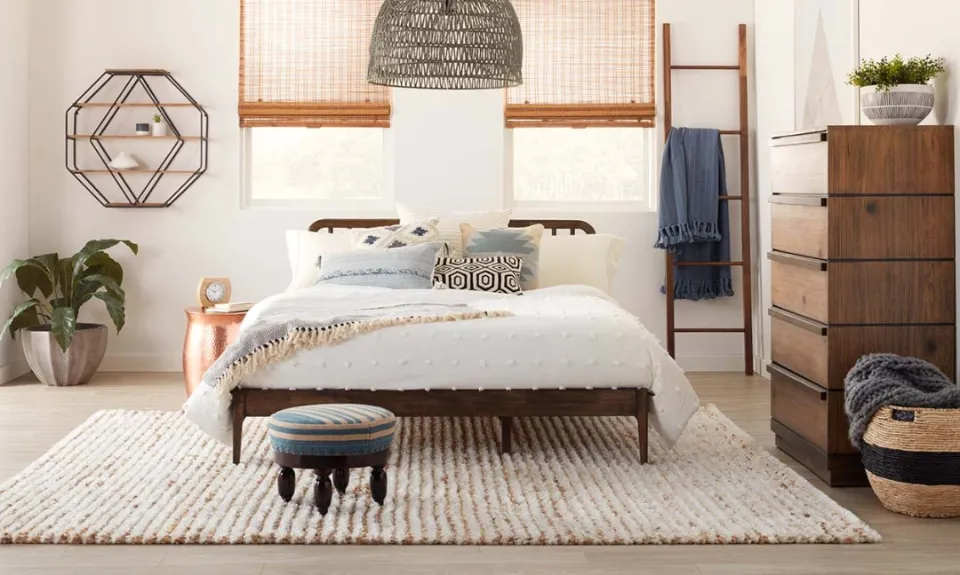
Pros of Having An Area Rug in Your Bedroom
Different people take different approaches to decorating their space. While some people might feel comfortable adding furniture over time, others prefer to set up their homes as soon as they move in. Some of us will concentrate on what to hang on the walls, others will prioritize texture and textiles, and still others will concentrate on the larger-ticket items like a living room sofa.
The nice thing about area rugs is that they pretty much check all these boxes at once! They can attract lots of attention because they are a sizable focal point in your room. In addition, the perfect rug is also highly personal, not only matching to your individual style but also adding a strong textural element to your room! This is crucial if you have hard floors and choose modern materials for your furniture, like metal and wood.
Area rugs are also helpful for creating smaller zones within a larger space. While at first glance that might give the impression that your room is smaller, it can actually give your space a lot more depth and interest.
It’s also a great way to divide up different areas of a room without obstructing the flow with bookcases or room dividers. It’s nice to feel like you both have a unified space for everything you need while enjoying the advantages of an airy, open living space, especially since open plan living spaces are still very popular. Larger bedrooms, dining rooms, and living rooms with uncomplicated furniture arrangements are the best places to observe the unifying effects of area rugs.
Last but not least, if you reside in an area with significant seasonal weather variations, area rugs are absolutely essential for comfort. There’s nothing worse than having to decide between wearing gloves inside or risking a colossal bill by turning up the heat. Whatever your heating situation, it can really add up over the course of a brutal winter.
While area rugs won’t magically transform your room into a breezy paradise, having rugs in both small and large rooms insulates your floor. Particularly if you have hardwood, laminate, or other types of flooring that are vulnerable to the cold, an area rug will trap the cool air before it can seep into your room and bring down the temperature.
Area rugs are a fantastic addition to your bedroom for this reason. There is quite literally nothing in the world worse than prying yourself out of your cozy bed early on a Monday morning, when the sun still isn’t up because it’s winter, and putting your feet down onto an ice-cold floor. We both just had a shudder, did you? You therefore require an area rug.
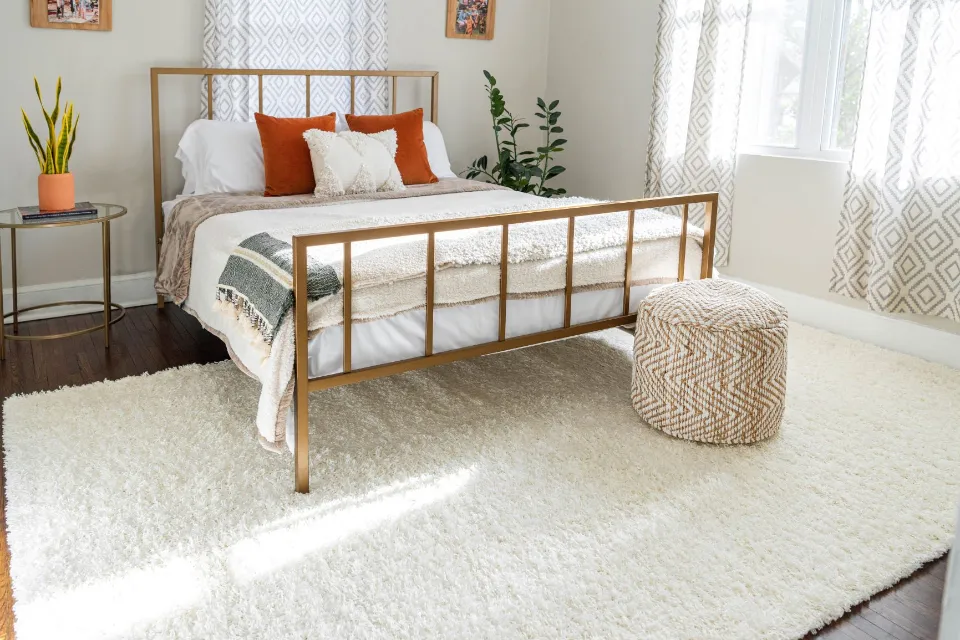
FAQs
How Far Should a Rug Be Placed under a Bed?
While the placement can depend on the size of the rug, bed and room overall, consider placing the rug with its length against the width of the bed, under the front two-thirds of your bed. Try to leave at least 2 to 3 feet of rug exposed on either side of the bed, regardless of the size of your room.
Should a Rug Be Centered in a Room?
The rug really needs to be centered on a major architectural element (fireplace, large windows, main focal wall) in the room. It doesn’t necessarily need to be smack dab in the middle of the room – you want its placement to be the island for the visual weight of the room.
How Do You Orient a Rug under a Bed?
Place the rug perpendicular under the bed with enough of the rug reaching out on the sides and in front to place your feet comfortably when getting out of bed or sitting at the foot. 8′ x 10′ or 9′ x 12′ – King Size Bed – Remember the “Bigger is Better” rule when it comes to arranging an area rug under a king size bed.
How to Layer Rug under Bed?
Personally I think a rug looks best under a bed when it’s layered in front of the nightstands exposing the flooring underneath them and stretching in front of the length of the nightstands on either side of the bed. Use the size of your nightstands as a guide for the width on each side of the bed to achieve this look.
Summary: Where Should You Place An Area Rug in a Bedroom?
Without a doubt, a bedroom can feel more cozy and opulent with the right rug. When deciding where to put a rug, take into account foot traffic, the size of your room and bed, and the rug’s size. After that, you can begin the fun process of buying a rug to add some extra personality and aesthetic appeal to your room with the knowledge that it will fit perfectly.
If you have any questions, please leave a comment. My Prime Home tries to give you the best furniture information. Thank you for reading.
Related:



